











|
|
Marine debris from the "Great Pacific Garbage Patch" washes up daily on Hawai'i's shorelines. The “Great Pacific Garbage Patch”, also called the North Pacific Subtropical Gyre, is an accumulation zone in the Pacific Ocean of marine debris covering an area twice the size of the United States of America. Currents and on-shore wind and waves bring marine debris to the Hawaiian Island chain where it is mostly found washed up on the windward (eastern) sides of the islands. Marine debris is found on the main Hawaiian islands - O`ahu, Hawai`i, Lana`i, Kaua`i, Moloka`i, Kaho`olawe, Ni`ihau and Maui as well as the Northwestern Hawaiian Islands.
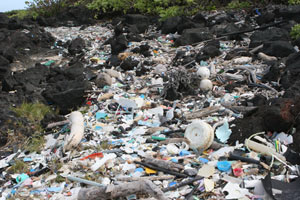 |
|
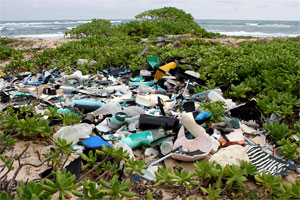 |
| Marine debris on Kamilo Beach photo: © Suzanne Frazer |
|
Marine debris on Kahuku Beach photo: © Suzanne Frazer |
Most marine debris found in Hawai`i is made of plastic. Plastic does not biodegrade, plastic lasts forever. Although it does photodegrade over time, this is a process that creates smaller and smaller particles of plastic creating microscopic particles.
Marine debris causes much more than an eyesore, it impacts marine life through habitat destruction, ingestion and entanglement.
Ingestion
| Researchers in the Northwestern Hawaiian Islands have found that 100% of albatrosses are feeding their chicks plastic (Nevins et al 2005). Adult albatrosses forage for food on the open ocean looking for squid and flying fish eggs. Instead however, they mistake brightly coloured plastic items floating on the surface of the ocean for food. Thousands of albatross chicks die each year in the Northwestern Hawaiian Islands with stomachs full of plastic such as caps, lighters, children’s toys, toothbrushes, fishing floats, and other brightly coloured plastic items. Ingesting plastic causes blockages, starvation, dehydration, and lacerations. |
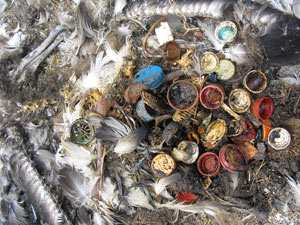 |
|
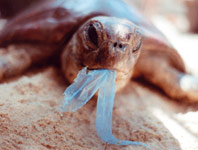 |
|
 |
Dead albatross chick
photo: © Cynthia Vanderlip |
|
Green sea turtle eating piece of a plastic bag
photo: © Ron Prendergast |
|
Plastic eaten bottles photo: © Dean Otsuki |
Sea turtles mistake plastic bags for food. They cannot regurgitate the plastic and so it causes internal blockages or makes the turtles positively buoyant so they cannot dive below the surface of the water. Sea turtles need to be able to dive to get food and if they can’t dive they will starve to death.
Many plastic bottles that wash ashore on Hawai`i’s beaches show evidence of teeth or beak markings where marine life and sea birds have attempted to eat them.
|
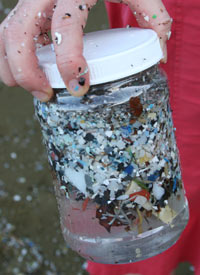 |
|
Most plastic fragments on Hawai`i’s windward shorelines are white and blue as marine life and sea birds are eating the colours that most resemble food.
|
| Water sample from Hanauma Bay photo: © Dean Otsuki |
|
Plastic fragments, Kahuku Beach photo: © Dean Otsuki |
Algalita Marine Research Foundation found that 35% of Lantern fish sampled from the Great Pacific Garbage Patch had ingested pieces of plastic. Lantern fish are the most common fish
in the open ocean and are consumed by larger fish such as tuna which are then eaten by humans and other animals at the top of the food chain.
Zooplankton has been shown to ingest microplastic particles indicating that the whole food chain is affected by ingestion of plastic.
| Plastic in the marine environment absorbs persistent organic pollutants (POPs) like DDT and PCB’s which have been found to be concentrated up to one million times more on the surface of the plastic than in the surrounding sea water (Mato et al 2001). These chemicals along with the chemicals that the plastic was made with, bioaccumulate up through the food chain and are endocrine disruptors which cause havoc to the endocrine systems of fish, reptiles, birds and mammals (CHEM Trust report, 2008). |
|

Nurdles photo: © Suzanne Frazer |
Entanglement
Marine debris such as nets, rope, strapping bands, eel cones and other objects are an entanglement hazard to marine life in the water and on beaches. Entanglement in marine debris can cause death to whales, dolphins, monk seals, sea turtles and sea birds if they are entangled underwater and unable to surface to breathe. Monk seals and sea turtles can become entangled when they come ashore. Marine debris also harms animals from cuts and wounds from marine debris. Monofilament line can sever off flippers and wings.
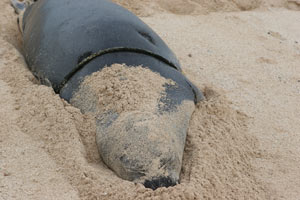 |
|
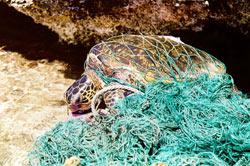 |
|
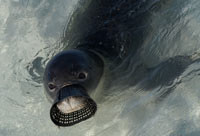 |
| Rope entangled around Monk seal mid-section photo: © Suzanne Frazer |
|
Green sea turtle entangled in fishing net photo: © James Watt |
|
Eel cone on monk seal's muzzle
photo: © Cynthia Vanderlip |
Habitat Destruction
Marine debris is often fouled with barnacles or algae from being in the ocean for many years. As fouled marine debris sinks it smothers coral reefs and blocks out sunlight. Marine debris also damages the reef when nets snag and pull on the reef causing breakage. Sometimes coral starts to grow on nets, crates, buoys and other items. When the item washes ashore, the coral dies.
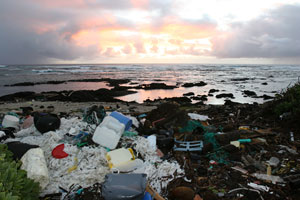 |
|
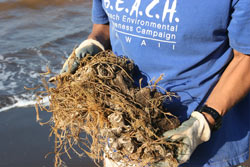 |
|
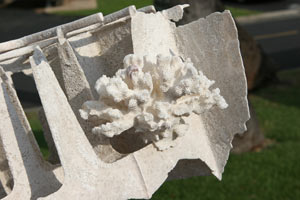 |
| Marine debris on Kamilo beach photo: © Suzanne Frazer |
|
Coral head that was pulled off a reef by a fishing net photo: © Suzanne Frazer |
|
Coral that grew on a crate
photo: © Dean Otsuki |
Shoreline habitat for marine life is lost when marine debris accumulates on beaches. Sea turtles need to come ashore to rest and to nest. When beaches are covered in marine debris, this makes building a nest impossible. Endangered monk seals come ashore to rest, give birth and nurse their young.
What can do to help save marine life?
1. become aware of keeping the environment free of litter by always putting trash in the right place (garbage bin) and never leaving cigarette butts and other trash behind
Reducing your use of plastic by:
2. bringing reusable shopping bags
3. using reusable cotton produce bags when buying fruit and vegetables
4. bringing reusable utensil sets with you when you eat out
5. bringing your own reusable bowls for take-out/take-away food
6. using reusable bottles
7. saying no thanks to plastic straws and don't use a straw OR use your own resuable glass straw, bamboo straw, metal straw
Other ways you can help:
8. pick up plastic and trash out of gutters, storm drains and other places so that it doesn't wash into the ocean
9. cut open the holes of six-pack rings before disposing of them and cut any other item that has holes that could entangle
10. don't release balloons
Beach Environmental Awareness Campaign Hawai`i (B.E.A.C.H.) volunteers provide
educational presentations on marine debris for students K-12 and teachers. To contact B.E.A.C.H. about visiting your school, phone: (808) 393 2168.
|
|
|
Coral Photograph Credit to the National Oceanic and Atmospheric Administration/Department of Commerce and Dr. James P. McVey. Dolphins, Japanese Angelfish, Green turtle, and Laysan Albatross photos by James Watt. Humpback whale photo by James Mobeley
Unless noted otherwise, the contents of this website are Copyright © 2006-2022 B.E.A.C.H. Please ask permission before using any text, graphics or photographs from this website. |



